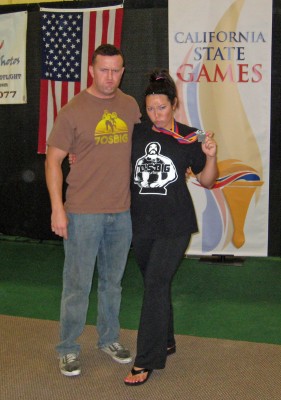Novemburly Beard of the Day
PR FRIDAY
Post your PR’s and training updates to the comments. Pictures of dogs are acceptable as well.
Deadlift Progression
The deadlift is peculiar exercise because it has the propensity to build massive strength and size, yet it can also hamper training when done incorrectly. I will briefly talk about the general procedure to increase the deadlift for a new trainee, talk about some ideas for the more advanced, and then open up the forum for what you may have done, seen, or read regarding advanced deadlift training.
Beginners
Someone that is brand new to lifting will be learning technique in all of their lifts and will be able to deadlift every workout. How fast someone advances is individualized. Former weight trainees and athletes will lift more weight, thus they will reduce their frequency of deadlifting sooner than someone who has been sedentary. Factors that affect this are strength and density of muscles, tendons, ligaments, and bones; systemic recovery ability; genetic potential for strength; technique; present muscular development; and desired soreness. Regardless of how fast someone can progress, the question lies with whether they should. If the frequency of deadlifting has been low or non-existent, then the progression in weight should be gradual. If a former high school athlete works up to deadlifting 350 for reps on his first or second day, he may cause damage to muscles or tendons that could prevent him from even squatting in his next workout. The Bill Starr axiom Patience + Persistence = Strength is incredibly important with training and programming.
Regular Novice
After the honeymoon phase of deadlifting, it would behoove the lifter to shift to deadlifting once per week. This allows ample recovery time between deadlift workouts. Some trainees deadlift early in the week and find that it hampers their next squat workout two days later. Instead, consider deadlifting at the end of the week because the weekend provides one more day of recovery before the next training session. If deadlift training hasn’t consisted of one work set of five reps, then the trainee should switch to it here. One work set of five reps ensures that the intensity is high enough to be an adaptive stress, yet the volume is low enough so that you can still continue on your linear progression. This wouldn’t be the time for multiple sets of five or sets of five across; crippling the lower back with high volume or high intensity deadlifts will be debilitating to the overall strength improvement as well as ruining the next workout.
A good goal would be to increase the weight lifted by about 15 pounds. This increment will be steady and should continue advancing for quite a while. If there was a particularly difficult workout, then it wouldn’t make sense to increase 15 pounds. If the last workout was equivalent to warming up, then it’s probably safe to increase more than 15 pounds. Keep in mind that as you advance (in how you adapt to stress or how much weight is on the bar), higher increases will be harder to recover from. Just because it’s possible to make a large increase doesn’t mean you should (remember, hindering your next workout isn’t conducive to getting stronger — leave your ego out of it). When you are more advanced, you should have a good understanding of what your body can and cannot handle (although some people never learn this awareness and make stupid decisions).
Advanced Novice
Once 15 pound increments start to “slow down” (i.e. become increasing difficult each deadlift workout), then 10 pound increments will be in order followed by increases of 5 pounds. Depending on lifting schedule, the lifter can adjust his program to deadlifting every 10 days and continue making 15 to 10 pound jumps. The extra recovery time will allow the larger increases to still occur. When deadlifting slows down every 10 days, then it may be time to deadlift every 14 days. This is what I did with Chris when he progressed his deadlift from the mid 400s for reps to the mid 500s for reps. He ended up pulling 545×5 and singled around 600. The problem with deadlifting on that schedule is that the lifter only deadlifts twice a month. If someone is interested in general strength for a sport, this infrequency may not be enough to give their musculature the appropriate work. If someone is interested in powerlifting, this infrequency (and lack of heavier deadlifting) won’t be conducive to getting ready for meets.
Intermediate and Beyond
The track that a trainee has taken up to this point is dependent on their ability, goals, and schedule. They may have deadlifted once a week consistently and resetted several times, or they may have elongated their progression by increasing recovery time between deadlift workouts (also with resets). One method that someone can shift to is doing a variation of the 5/3/1 on their deadlift. This isn’t the same as literally doing Wendler’s program, but it takes the principle from it. In week 1, the lifter would do a medium-heavy work set of five reps. They wouldn’t try for a PR or a max set, but something that gives them some work. The next week they’d aim to increase the weight (perhaps 20 pounds), and do it for a triple. Again, it shouldn’t be a 3RM or a 10 on a rating of perceived exertion scale. The following week they’d increase the weight again and do a single. If the single was easy, then they could repeat it for another single, or add a bit of weight. The idea is to reduce the volume while increasing the intensity every week, so the last week shouldn’t exceed two or three reps. The fourth week can be a light deadlift day, or accessory day (e.g. RDL’s if they aren’t done regularly).
This set up would provide an undulating volume/intensity pattern for deadlift training, and give the lifter some rest at the end of the month. When I was first thinking about this programming idea, Gant was worried that the fourth week should be a total reduction in volume like the original 5/3/1. Gant is a proponent of reductions in training on a regular basis — and for good reason. Regular reductions allow your body’s recover capabilities to catch up with the stress imparted on it. This is relevant to casual* and older lifters**. However, younger lifters (<30 years old) who train seriously probably don't require this every four weeks. The reduction of deadlift stress in that fourth week along with the potential reduction of other lifts should be enough. This shouldn't have to be said, but if you are feeling run down or spread thin, then it's time to reduce your training for the sake of recovery — this fourth week is a perfect time for that.
The subsequent months of this 5/3/1 style of deadlifting should see more weight used on each day. The sets of 5, 3, and 1 should be higher than they were the previous month without overtraining. The lifter who can walk that knife’s edge will be rewarded with a progressing deadlift. This style of programming the deadlift can be altered to the lifter’s needs; 5/3/2, 3/2/1, and 3/2/2 are all valid. A more advanced trainee could even change the rep scheme depending on how many months out from a meet he is. Six months out could see something like 8/5/3 or even 12/8/6. Who cares? The idea is to adjust your training to continue making progress. The major difference with Wendler’s program is that I wouldn’t recommend the lifter to go for maximum reps on a given day; I’m merely just using the general rep scheme. Too many reps would increase the volume and ruin the effectiveness of a Texas Method or split routine style program. Remember that the 5/3/1 has less volume than a Texas Method, and that’s why going for max reps is possible and effective. Keep in mind that the entire program can be shifted to Wendler’s exact program for great success; everything I’ve written here is relevant to programming the deadlift on an intermediate style program where volume and intensity are manipulated weekly (like the Texas Method).
Open Forum
I gave just one example of how you can progress your deadlift beyond the novice stage, yet it isn’t the only way. I’ve asked a couple of readers with solid deadlifts to give their thoughts in the comments, so feel free to share what you have done for your advanced training. If you are deadlifting over 500 pounds then it would be interesting to hear what you have done, seen, or read about. If the training you share with us is only relevant to lifters on drugs, then please clarify so it doesn’t mislead aspiring deadlifters (in other words, if you mention Westside or equivalents, clarify who you’re talking about).
*Casual lifters are those who want to get stronger, but it isn’t their main focus in life. This is okay; you don’t have to be passionately married to a barbell. It’s better to be honest with yourself and say, “I like getting stronger, but it isn’t top priority in life, yet I will continue to train consistently to get stronger and more muscular over time for x reason(s).”
**This statement can also be applied to people of any age who are beginning to lift for the first time in their life. The high school and collegiate cross country runner’s body will be inept at dealing with the stresses of lifting continuously, and thus they may require more patience and slower increases in weight over time. Getting stronger is a process, and if your body has never done it before (or hasn’t in a long time), you must respect that fact.


